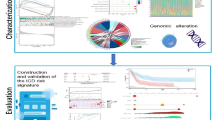Abstract
The aim of the study was to observe the variation of CD4+CD25+ regulatory T cells in periphery blood and tumor microenvironment of non-small cell lung cancer (NSCLC) patients and the effects of CpG ODN. The proportion of CD4+CD25+ regulatory T cells, Foxp3 gene expression, levels of tumor growth factor-β (TGF-β) and immunoreactive fibronectin-γ (IFN-γ) in the periphery blood of 30 NSCLC patients and 30 healthy volunteers were compared. These indicators were compared before and after CpG ODN treatment. Foxp3 gene expression in the tumor microenvironment of NSCLC patients was also observed. The results showed CD4+CD25+ regulatory T cell proportion, Foxp3 expression and TGF-β levels in the periphery blood of NSCLC patients were higher than those of healthy volunteers (p < 0.05), and these indicators of patients were significantly decreased after CpG ODN 2006 treatment (p < 0.05). Foxp3 expression in the metastatic lymph nodes was higher than that in the non-metastatic ones of NSCLC patients (p = 0.000). In conclusion, a rise in the proportion of CD4+CD25+Foxp3+ regulatory T cells was demonstrated in the periphery blood and tumor microenvironments of NSCLC patients. CpG ODN 2006 downregulated the CD4+CD25+Foxp3+ regulatory T cells proportion and TGF-β levels in the periphery blood of these patients.



Similar content being viewed by others
References
Sakaguchi S, Sakaguchi N, Asano M, Itoh M, Toda M (1995) Immunologic self-tolerance maintained by activated T cells expressing IL-2 receptor alpha-chains (CD25). Breakdown of a single mechanism of self-tolerance causes various autoimmune diseases. J Immunol 155:1151–1164
Rudge G, Gleeson PA, van Driel IR (2006) Control of immune responses by immunoregulatory T cells. Arch Immunol Ther Exp (Warsz) 54:381–391
Field EH, Matesic D, Rigby S, Fehr T, Rouse T, Gao Q (2001) CD4+CD25+ regulatory cells in acquired MHC tolerance. Immunol Rev 182:99–112
Somasundaram R, Jacob L, Swoboda R, Caputo L, Song H, Basak S et al (2002) In–ibition of cytolytic T lymphocyte proliferation by autologous CD4+/CD25+ regulatory T cells in a colorectal carcinoma patient is mediated by transforming growth factor-beta. Cancer Res 62:5267–5272
Gajewski TF, Meng Y, Harlin H (2006) Immune suppression in the tumor microenvironment. J Immunother 29:233–240
Sfondrini L, Besusso D, Bronte V, Macino B, Rossini A, Colombo MP, Ménard S, Balsari A (2004) CpG-Oligodeoxynucleotides activate tyrosinase-related protein 2-specific T lymphocytes but do not lead to a protective tumor-specific memory response. Cancer Immunol Immunother 53:697–704
Smyth MJ, Teng MW, Swann J, Kyparissoudis K, Godfrey DI, Hayakawa Y (2006) CD4+CD25+ T regulatory cells suppress NK cell-mediated immunotherapy of cancer. J Immunol 176:1582–1587
Zou W (2005) Immunosuppressive networks in the tumour environment and their therapeutic relevance. Nat Rev Cancer 5:263–274
Shevach EM, DiPaolo RA, Andersson J, Zhao DM, Stephens GL, Thornton AM (2006) The lifestyle of naturally occurring CD4+ CD25+ Foxp3+ regulatory T cells. Immunol Rev 212:60–73
Enarsson K, Johnsson E, Lindholm C, Lundgren A, Pan-HammarstrÖm Q, StrÖmberg E et al (2006) Differential mechanisms for T lymphocyte recruitment in normal and neoplastic human gastric mucosa. Clin Immunol 118:24–34
Curiel TJ, Coukos G, Zou L, Alvarez X, Cheng P, Mottram P et al (2004) Specific recruitment of regulatory T cells in ovarian carcinoma fosters immune privilege and predicts reduced survival. Nat Med 10:942–949
Wolf AM, Wolf D, Steurer M, Gastl G, Gunsilius E, Grubeck-Loebenstein B (2003) Increase of regulatory T cells in the peripheral blood of cancer patients [J]. Clin Cancer Res 9(2):606–612
Read S, Malmström V, Powrie F (2000) Cytotoxic T lymphocyte-associated antigen 4 plays an essential role in the function of CD25(+)CD4(+) regulatory cells that control intestinal inflammation. J Exp Med 192(2):295–302
Nakamura K, Kitani A, Strober W (2001) Cell contact-dependent immunosuppression by CD4(+)CD25(+) regulatory T cells is mediated by cell surface-bound transforming growth factor beta. J Exp Med 194:629–644
Yu P, Lee Y, Liu W, Krausz T, Chong A, Schreiber H, You Z, Kaynor C, Wang X, Fu YX (2005) Intratumor depletion of CD4+ cells unmasks tumor immunogenicity leading to the rejection of late-stage tumors. J Exp Med 201:779–791
Seo N, Hayakawa S, Takigawa M, Tokura Y (2001) Interleukin-10 expressed at early tumour sites induces subsequent generation of CD4(+) T-regulatory cells and systemic collapse of antitumour immunity. Immunology 103:449–457
Chen ZM, O’Shaughnessy MJ, Gramaglia I, Panoskaltsis-Mortari A, Murphy WJ, Narula S, Roncarolo MG, Blazar BR (2003) IL-10 and TGF-beta induce alloreactive CD4+CD25- T cells to acquire regulatory cell function. Blood 101:5076–5083
Vollmer J, Weeratna R, Payette P, Jurk M, Schetter C, Laucht M, Wader T, Tluk S, Liu M, Davis HL, Krieg AM (2004) Characterization of three CpG oligodeoxynucleotide classes with distinct immunostimulatory activities. Eur J Immunol 34:251–262
Law JP, Hirschkorn DF, Owen RE, Biswas HH, Norris PJ, Lanteri MC (2009) The importance of Foxp3 antibody and fixation/permeabilization buffer combinations in identifying CD4+CD25+Foxp3+ regulatory T cells. Cytom A 75(12):1040–1050
Acknowledgments
This work was supported by Fudan University Youth Research Fund (Kebu 163).
Conflict of interest statement
The authors declare that they have no financial conflicts of interest.
Author information
Authors and Affiliations
Corresponding author
Rights and permissions
About this article
Cite this article
Wang, YY., He, XY., Cai, YY. et al. The variation of CD4+CD25+ regulatory T cells in the periphery blood and tumor microenvironment of non-small cell lung cancer patients and the downregulation effects induced by CpG ODN. Targ Oncol 6, 147–154 (2011). https://doi.org/10.1007/s11523-011-0182-9
Received:
Accepted:
Published:
Issue Date:
DOI: https://doi.org/10.1007/s11523-011-0182-9




